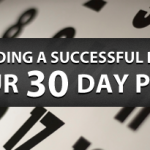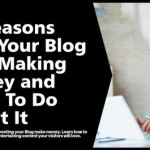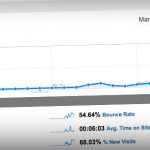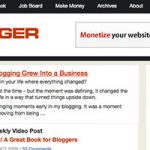
A journey of a thousand miles begins with a single step.
That’s a quote by the Chinese philosopher Laozi and it’s particularly relevant to new bloggers. That first step is the most important one, but what does it entail?
Let’s say you bought a domain, set up hosting, and installed WordPress. What comes next? How do you start blogging with the end in mind? Here are ten things you should do on day one of your blog (or today, if you’re past day one).
Let’s Assume You’ve Done Your Research
Before you purchase a domain, there a number of things you need to consider. For the sake of this article, we’re going to assume that you already:
- Chose a specific audience with problems that you know how to solve.
Always start with an audience, not a topic. Choose to help people that you are qualified to help. - Found and subscribed to the top related blogs in your niche.
Use the How to Get Bloggers to See and Follow Your Blog post to find out how to find other bloggers in your niche. Then subscribe to their feed and start following their posts. - Read free posts, ebooks, and resources from your niche.
Once you’re subscribed, spend a few days reading the free posts and ebooks they give you. Read both for the content and to see how they do what they do.
If you’d like more of my thoughts on any of these steps, let me know in the comments.
Technical Tasks for Your Blog
Here are five technical components of your blog that you need to take care of prior to writing a single post.
1. Burn Blog with FeedBurner
Every major blog that I can think of, including Copyblogger, Problogger, TechCrunch, and Mashable, all serve up their RSS feeds through the Google-acquired tool, FeedBurner. It’s become the industry standard because it’s by Google, it integrates with other software, and it’s been around for a long time.
To burn your blog with FeedBurner:
- Go to feedburner.com.
- Sign in with your Google account.
- Burn your feed by plopping your url in the box.
- Click next.
- Select your feed. It should be domain.com/feed if you’re using WordPress.
If you were wondering how Michael integrates his RSS feed with Aweber, this is the first step in that process. Even if you’ve been blogging for awhile, it’s important to do this as soon as possible so all of your subscribers reside under one roof.
2. Place Opt-In Forms
The money is in the list … If I could do one thing differently, I would have started building my list earlier … The most important call to action for bloggers is to encourage people to subscribe.
You’ve heard all of that countless times. You can’t start building your list until your site has opt-in forms.
No matter which email platform you use (even FeedBurner has an email subscriber option), the process of putting opt-in forms on your site is, in most cases, a matter of copy/pasting the code. Here are a few places to put those forms:
- Right side of the header.
- Top of the sidebar.
- Bottom of posts.
- Footer area.
- Featured on the homepage.
- Lightbox with Popup Domination.
3. Write Your About Page
Your about page will be one of the most viewed pages on your site because readers like to know the people behind the site.
I was listening to a Derek Halpern interview on Smart Passive Income the other day, and this was Derek’s advice on how you should organize your about page:
- What will this website do for the visitor? Followed by an opt-in box.
- Establish yourself as an expert. Followed by an opt-in box.
- Build a personal connection with your story. Finish it up with an opt-in box.
Treat your about page as a sales letter for why somebody should follow you and your site. If you do a good job, they’ll want more information from you, hence the opt-in.
4. Create a Contact Page
Once you have an about page, the only other page you need to launch your blog is a contact page. I include two things on my contact page:
- Contact information.
I list my email, Skype ID, Twitter, LinkedIn, Facebook, and Google Plus. - Contact form.
Sometimes people prefer to email you directly from the site. Include a contact form by using the Contact Form 7 and Really Simple CAPTCHA plugins.
Planning Content for Your Blog
Once you have the technical components of your blog worked out, it’s time to focus on the most important part, the content.
5. Choose Your Categories
Within WordPress, you create categories for your posts. These categories help organize your site both for your readers and for search engines.
Category pages display your archived posts based on the category you choose.
To set up your category pages, go to Posts > Categories and be sure to include your meta data as well as an introductory headline/content.
6. Pick Your Pillar Articles
After you create the category pages, think about how you can create a pillar article for each category.
A pillar article is different than a category page in that it’s an ultimate resource post (i.e. 101 Ways to Make Money Online) with links to your in-depth articles.
These posts get lots of traffic. You can even create a secondary navigation menu, like the one on Income Diary, to highlight the pillar articles on your blog.
7. Brainstorm a List of Blog Posts
Once you’ve chosen your categories and pillars, start brainstorming different posts that solve problems and fit within the scope of those categories. I like to brainstorm with a notebook and a white board.
To aid in and filter down this brainstormed list, do a little keyword research to figure out which keywords and blog post topics people are searching for.
You’ll use this brainstormed list to create your editorial calendar.
8. Create an Editorial Calendar
An editorial calendar is a fancy term for planning which blog posts you’re going to write and publish on which days.
You can simply schedule your blog posts in a planner/calendar. If you’d like to take this process to the next level, you can use the Editorial Calendar plugin.
This step isn’t necessary but it will keep you focused and on schedule for creating content for your blog.
9. Write a Ton of Posts
One of the biggest mistakes that new bloggers make is that the start telling people about their blog when they only have a few posts written. As soon as you start telling people about it, you have a responsibility to keep it updated.
Based on how seriously you want to take your blog, this is how many blog posts you need to write prior to publishing the first post:
- Recreational Blogger: 5 posts
If you’re testing the blogging waters, start with writing 5 posts. Publish the first three, tell people about them, and schedule the next two. - Intermediate Blogger: 10 posts
If you’re fairly certain you want to keep up with blogging, write 10 posts to see if it’s something that you enjoy doing. - Serious Blogger: 20 posts
If you’re blogging to better your business, start by writing 20 posts. - Career Blogger: 50 posts
If blogging is your business, write 50 posts before you tell anyone. As soon as you launch, it’s going to be tough to keep up with a rigorous posting schedule. It’ll be nice to have a couple dozen posts sitting in the queue.
If you’ve already launched your blog, there’s a good chance your posting schedule has waned since the first few months. Consider taking a hiatus so you can build up a stockpile of focused content and re-launch it in a few months.
10. Strategize Your Funnel System
Man, you’ve had a busy day. The final thing you need to figure out before you start telling people about your new blog is your funnel system.
The first step in developing your funnel system is figuring out what you want people to do. Maybe it’s to become a subscriber or purchase a product. This is the goal of your site.
Whether your goal is to get them to subscribe or to purchase, I think your funnel system should be the same:
Read > Subscribe > Free Report/Auto-Responder Series > Blog Post Broadcast > Purchase
Getting somebody to purchase something from your site is like asking them to marry you. You can’t pop the question right away. You need to start by getting their phone number or email. Begin building trust by hanging out with them, giving them free content. After awhile, you’ll be in a relationship. Then one day they’ll trust you enough to buy.
The Final Word
I have a feeling that you’re past day one on your blog. That’s ok. These things still matter. Even if you’ve been blogging for years, these tips will help revitalize your blogging as though it’s day one all over again.
Sometimes it’s nice to go back to day one. You were probably pretty excited about what you’re doing now. Keep up that enthusiasm and let me know how I can help.
Photo by: Stuck in Customs











